Walking Tours
Home Page
Downtown San Diego
a walking tour by Carol Mendel
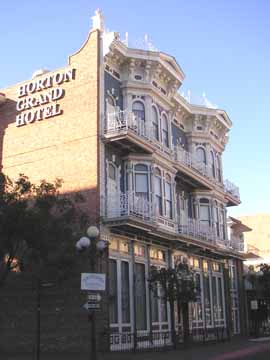
|
Horton, a San Francisco merchant, came to San Diego in 1867, almost 100 years after Portola and Serra. He immediately decided that the San Diego that had grown up around the first settlement was too far from the bay. Accordingly, he would buy land several miles south of that settlement and build a new San Diego.
The townspeople scoffed. Seventeen years earlier, another man, William Heath Davis, had the same idea, tried it, and gave up in defeat two years later. But Horton was undaunted. He bought 960 acres of barren land for a then-generous price of $265 (an average of 27-½ cents per acre), and began to build his New Town. New Town had its economic ups and downs, and on one of the downs Horton himself lost almost all the money he had made, but the city persevered. The original San Diego settlement survives as Old Town, a restored reminder of Old California, but New Town is today's downtown San Diego.
The decade of the 1960's brought a radical change to the downtown area -- its skyline began to sprout sleek modern high-rise buildings. Yet some of the older "New Town" also remains, especially in the area today known as the Gaslamp Quarter. On a short walk through the heart of the city you can discover much of the best of both the old and the new. This self-guided walking tour takes a roughly chronological approach, beginning with a look at San Diego's early times and ending with more recent things.
Distance: Approximately a mile and a half. Time: Two hours, plus whatever time you spend at the museums.
MAP of the walking tour
Terms of Use
Begin your walking tour of downtown San Diego at Horton Plaza Park, on Broadway between Third and Fourth Avenues.
Alonzo Horton was honest, straight-forward, and dedicated to San Diego. Immediately after buying the land for his new San Diego, he laid out its streets and lots and began to promote them. To get the ball rolling, he gave away free lots to every religious denomination that would build a church, and 20 more free lots to people who would agree to build houses. Houses, if you please, not shacks -- they had to be at least 12 feet wide, 16 feet long, and 12 feet high.
He built a wharf at the foot of Fifth Avenue. Then, expecting that a railroad would soon connect San Diego with the East, bringing in tourists and settlers, he built a large 100-room hotel, the Horton House, on the north side of Broadway, across from the plaza where you are now standing. The hotel opened in 1870, just three years after Horton had first come to San Diego. For its time, the Horton House was lavish, offering in every room such amenities as carpets, marble top tables, and even a washstand with hot and cold running water.
Horton was concerned enough about the view from his hotel that setting out a plaza in front of it was not enough -- he also widened Broadway, from the plaza to the waterfront, by twenty feet, thereby giving hotel guests a better view of the harbor. So although the Horton House no longer exists, Broadway still gets wider west of the plaza.
In 1905 the Horton House was torn down to make way for the U.S. Grant Hotel, put up in honor of the Civil War general and U.S. President by his son, Ulysses S. Grant, Jr., a San Diego businessman. The U.S. Grant remains on the site, still a fine hotel.
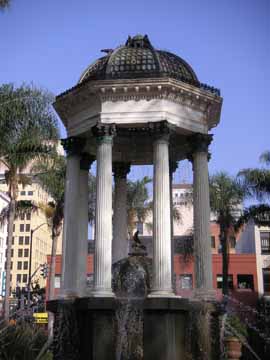
|
You will notice that the blocks are very short. Small blocks mean more corner lots, which always sell at a premium. With this in mind, "Corner Lot Horton" made his blocks 200 by 300 feet instead of the normal 300 by 600 feet. There are no alleys between the blocks because Horton thought that typically alleys only accumulated trash.
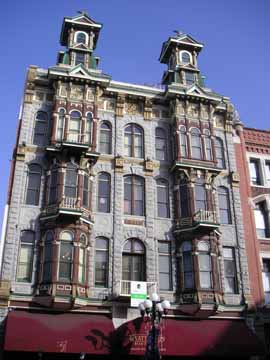
|
In the years since then, the area has been rejuvenated, as building after building has been refurbished, repainted, and returned to its Victorian prime. The renovated buildings now house restaurants, offices, and shops.
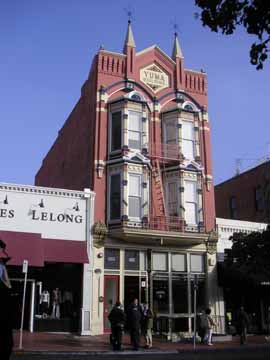
|
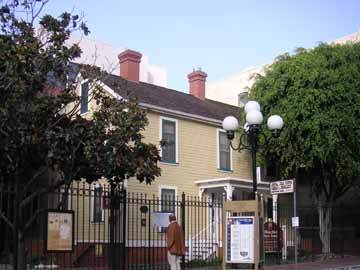
|
Diagonally across the street is the Horton Grand Hotel. (See photo at the top of this walk.) Today's hotel is a combination of two Victorian hotels. In Victorian times, the one on the left as you face the entrance was the Grand Hotel (later renamed the Horton Hotel), and the other was the Brooklyn Hotel, which later became a saddlery.
When you have finished looking at the Horton Grand, continue along Island Avenue and turn left at Third Avenue. At the corner of Third Avenue and J Street you will find the San Diego Chinese Historical Museum, which features the history of San Diego's Chinatown as well as Chinese art, history, and culture.
You next head east on J Street, and continue up to Sixth Avenue, where you will turn left.
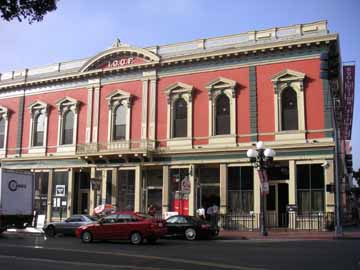
|
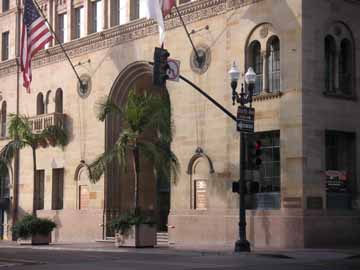
|
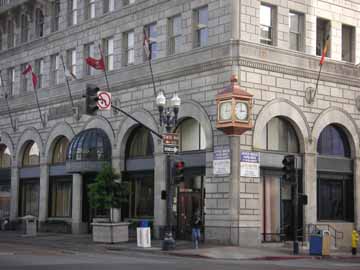
|
More than anyone else, John D. Spreckels brought economic life to San Diego. Like Horton, Spreckels was a San Francisco businessman who fell in love with San Diego on his first visit and decided to work to make it a thriving city. Spreckels arrived in 1887, twenty years after Horton, and, unlike Horton, had the money to make heavy investments in the San Diego economy. (The Spreckels Sugar Company, which his father had founded, had become immensely successful. In addition, Spreckels' own shipping business had been highly profitable.)
Spreckels proceeded to finance the ventures that formed the economic backbone of San Diego. His first, a wharf for coal bunkers in 1888, preserved San Diego's only railroad link. (The Santa Fe Railroad Company, which ran a spur from Los Angeles to San Diego, was expecting to close the run for lack of a good fuel supply here.) He then went on to bail out the major showpiece and tourist attraction of the area, the foundering Hotel del Coronado. He bought a newspaper, The San Diego Union. He financed a dam and water company to bring in much-needed water, and he ran the San Diego Railway Company, providing transportation all over the city. He built theaters, office buildings (including this one), and hotels. And, as his crowning achievement, he financed the building of the San Diego and Arizona Railroad, bringing San Diego its own direct railroad link to the East.
Continue along Sixth Avenue and cross C Street. Two lines of the San Diego Trolley run along C Street from the Santa Fe Depot, San Diego's train station. The Blue line goes to the Mexican border, and the Orange line goes to El Cajon. A trip from downtown to the Mexican border takes about 45 minutes.
When you reach B Street, turn left. You are now on the edge of the main financial district. A and B Streets are the home of many banks, including the Bank of America, California Bank & Trust, Union Bank, and Wells Fargo.
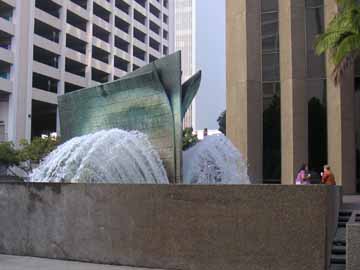
|
Turn left and walk south. As you leave the plaza, you will pass under the City Administration Building, San Diego's City Hall. Leave the plaza by the C Street exit. Continue along Second Avenue to Broadway and turn right. On your left you will pass the Spreckels Theater, a neo-baroque theater built in 1912.
Turn left at First Avenue. In one block, at the corner of E Street, turn left again and go through the arch beside the Westin Hotel. Passing by the hotel, you come to the former Westfield Horton Plaza shopping center. This property is now in the process of being converted into a mixed-use office campus catering to tech firms. Intended to open sometime in 2021, it will be called "The Campus at Horton."

|
Return to top.
|
Enjoy this walking tour?
Check out the others in this series Balboa Park Cabrillo National Monument Downtown San Diego The Embarcadero La Jolla La Playa Mission Bay Park Mission Beach Old Town Shelter Island Sunset Cliffs |
Enjoy full-color illustrated maps? Check out the ones below. Some can be purchased as laminated maps, some as folded maps, some as wooden trays, and some as all three. San Diego Los Angeles Palm Springs Santa Barbara San Francisco Bay Area Las Vegas Salt Lake City Oregon Washington DC |